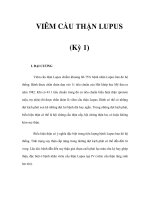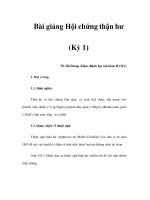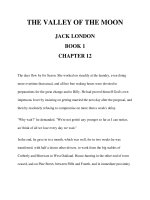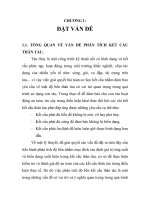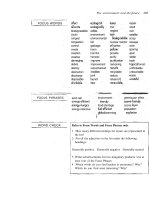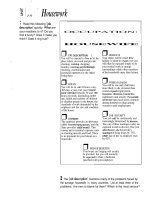more than words book 1 phần 1 ppsx
Bạn đang xem bản rút gọn của tài liệu. Xem và tải ngay bản đầy đủ của tài liệu tại đây (387.43 KB, 20 trang )
MORE
THAN
WORDS
vocabulary for upper intermediate
to advanced students
BOOK 1
Addison
Wesley Longman
Limited
Edinburgh
Gate,
HarTow,
Essex
CM20
2JE, England
and Associated companies throughout the world
© Longman Group UK Limited
1991
All rights reserved; no part of this publication
may
oe
reproduced, stored in a retrieval system,
or transmitted in any form or by any means, electronic,
mechanical, photocopying, recording, or otherwise,
without the prior permission of the Publishers
First published
1991
Set in 1
l/13pt
Futura
Medium
Designed and produced by
The Pen and Ink Book Company Ltd.
Huntingdon, Cambridgeshire
Illustrated by Maureen and Gordon Gray,
Hamish
Moyle,
Dave Parkins and John York
Fifth impression
1997
British Library Cataloguing in Publication Data
Harmer, Jeremy,
1947—
More than words: vocabulary for upper intermediate to
advanced students.
Book
1.
I. Title II. Rossner, R. (Richard)
428.1
Printed in China
EPC/05
ISBN
0-582-09481-X
Contents
Acknowledgements
Introduction for students and teachers
Part A: Exploring Vocabulary
UNIT
Meaning
Word Use
Word Formation
Word Grammar
NO
1
2
3
4
5
6
7
8
9
10
11
12
TITLE
Meaning in context
Related and unrelated meanings
Sense relations
Metaphor, idioms, proverbs
Collocation — which word goes
with which?
Style and register
Parts of speech: verbs and nouns
Affixes
Spelling and sounds
Countable and uncountable
Verbs
Verb complementation
Part B: Human Beings
UNIT
Answer Key
NO
1
2
3
4
5
6
7
8
9
10
11
12
13
14
15
16
TITLE
The human body
Physical appearance and
description
Clothing
Health and exercise
Sickness and cure
Ages and ageing
Birth and death
Waking and sleeping
Walking and running
Body language and movement
The mind and thinking
Perception and the senses
Feelings and moods
Likes and dislikes
Character and personality
1
Character and personality 2
iv
¥
1
2
5
9
12
17
20
26
30
33
36
40
45
51
52
57
63
71
78
84
91
98
104
111
118
126
133
141
148
155
160
Acknowledgements
We would like to thank Sue Maingay for her help and
encouragement during the writing of these materials
and Jane Walsh for her constructive comments. Thanks
also to Alison Steadman for all her work.
As the work has gradually evolved we have been
lucky in the excellent reports that we have received from
Janet
Olearski,
Alison Roberts and Bernard Hayden.
We were able to try the materials out at the Cambridge
Eurocentre and the Cambridge Regional College
(where Anita Harmer's comments were also extremely
useful). Thanks to both organizations for allowing us to
get valuable feedback.
Lastly, and with feeling, our gratitude is due to Anita
and Annick for their support and patience.
Jeremy
Harmer
Richard Rossner
Cambridge. July
1991.
We are grateful to the following for permission to
reproduce copyright material;
Adverkit International Ltd for an extract from an
article from Bath & District Star
1.11.89;
Faber &
Faber Ltd for the poem
'Giving
Up
Smoking'
from
Making Cocoa for Kingsley Amis by Wendy Cope;
the author's agent for an adapted extract from The
Truth About Lorin Jones by Alison Lurie; the author's
agent for the poem
'Worry'
from Melting into the
Foregroundby
Roger McGough (pub Kestrel Books);
The Open University Press for an adapted extract
from Unit 6 from course D303 by The Open
University (pub
1978),
(c) The Open University Press;
the author, Michael Swan for his poem
'Old
Friend
Seen on TV.
We have been unable to trace the copyright holder
in the article
'Your
Horoscope'
by Lucille Burton &
would appreciate any information that would
enable us to do so.
Thanks are due to the following for permission to
reproduce photographs on the pages indicated:
J. Allan Cash Ltd: pp. 5, 76,
107
(bottom centre and top
left),
116,
148-151,
153,
155(c),
159;
Catherine
Ashmore: p.
111
(f);
BBC: p. 94 (top left); Peter Cotton and
Mark Harrison, Abacus/Sphere Books: p. 2; Peter Dazeley:
p. 73 (top);
Zoe
Dominic: p.
Ill
(b); ET Archive: p. 54;
Format Photographers Ltd/Jenny Matthews: pp. 78(d),
111
(c),/Maggie Murray: pp. 71 (e), 73 (bottom
centre),/
Joanne O'Brien: p. 94 (middle
rightj/Brenda
Prince: p. 94
(bottom left); Format
Partners/Ulrike
Preuss: p.
78(b)(e);
Tim
Graham: p.
111
(d); Sally and Richard
Greenhill:
pp. 34
(main photo), 37, 43, 61 (a)(d), 73 (bottom left), 78(c), 94
(middle left and bottom right)
107
(bottom right); Robert
Harding Picture Library Ltd: p.
107
(top centre); The Image
Bank: pp.
139,
152;
Japan National Tourist Organisation:
p. 71 (a); Mary Evans Picture Library: p.
157;
Dept. of
Medical Illustration, St.
Bartholomew's
Hospital: p.
118;
Network
Photographers/Sunil
Gupta pp. 57(d), 94 (top
right);
Photofusion/Anna
Arnone: pp. 57(b),
71
(c),/Janis
Austin: pp. 57(a)(e),
107
(bottom left),
145(d)/Vania
Coimbra: p. 71 (d),/Gina Glover: p.
107
(top
right),/Sally
Lancaster: pp.
57(f),
145(b),/Sarah
Sounders
p. 63 (bottom
right),/J.
Southworth:
p. 63 (top
right),/Sarah
Wyld
p.
145(a)/Vicky
White: p.
78(a);
Popperfoto:
pp. 71 (b),
111
(e); Walter
Rowlings:
p. 34 (inset); Rex Features Ltd:
pp.
15,
61
(b), 73 (bottom right),
101,
145;
Chris Ridgers:
p.
141;
Roose and Partners: p.
78(f);
Syndication
International: pp. 57(c),
61
(c); Zefa: p. 52, - K+H Benser:
p. 63(a), - Norman: p.
111
(bottom left); -
Stockmarket:
p. 63 (top left), - Teasy: p. 85.
Introduction for students and teachers
AIMS
The
aims
of
More than
Words
are:
a) to make students more aware of words and what it means
to know and use words fully (especially in English).
b) to make students aware of the vocabulary associated with
certain defined topic areas (e.g. health, sleeping and
waking, clothing, feelings and moods, relationships,
character etc.): to provide material to help students
memorize and practise these words.
c) to provide material which will provoke and stimulate, thus
enabling the students to understand more about the
vocabulary of English and how language works.
d) to provide material which can be used to promote general
skill integration work and other types of language study.
THE ORGANIZATION
OF MORE THAN
WORDS
There
are two
books
in the
'More
than Words'
series.
Each
book has Part A and Part B.
This is what the different parts contain:
BOOK1
Part A: Exploring Vocabulary
12 units designed
to
help the students develop an awareness
of different aspects of meaning such as
metaphor,
collocation etc. and of how words are used. In the units we
also look at how words can be changed and how they
behave grammatically.
Part B: Human Beings
16 units covering people and human
experience.
We look at
the vocabulary associated with the
body,
health,
movement,
the mind, perception, likes and dislikes, character etc.
Introduction for students and teachers
BOOK
2
Part A: Resources for Vocabulary Development
6 units dealing with the resources which students can use
to help them develop their own vocabulary; two deal with
dictionary use and there is a unit on how to remember new
words. Other units deal with
'circumlocution',
wordbuilding and creative vocabulary.
Part
B:
The World
25 units covering topic areas concerned with the world we
live in. We look at the vocabulary associated with families,
communication,
politics,
homes, towns and cities,
education,
crime, the environment, the animal kingdom etc.
WHAT IS
VOCABULARY?
A
glance
at the
contents
list
of
More than
Words
will
show
you
that there is more to the book than simply a list of topics and
the words associated with them.
To know a word fully you need to be aware of many things,
for example
a) you need to know what a word means (let's take the word
'dream'}
b) you need to know how it is connected to other words which
mean similar things (e.g.
nightmare]
i
c) you need to know what other meanings it can have (e.g.
"/
never dreamt I could be so happy"
"He's
always
daydreaming"
"I
wouldn't dream of it" etc.)
d) you need to know how the word changes depending on its
grammar (e.g. she was dreaming, she dreamt)
e) you need to know the grammar of the word (e.g. you
dream
of
or about something)
f) perhaps, most importantly, you need to know what kind of
situations the word is used in and who might use it.
All this information is part of
'knowing'
a word: it's
information that speakers of the language have without
even
realizing it.
In
More than
Words
we try to
ensure that students have
a
chance to know words in this way. Texts show the contexts
words are used in, and exercises explore various aspects of the
words such as collocation, style and grammar.
A
major feature
of
More than
Words
is
Part
A:
Exploring
Vocabulary, where students are made aware of what is
involved in
'knowing'
a word fully.
Introduction for students and teachers
m
Part A can also be used as a reference section by students
working on a unit in Part B. Some exercises have headings
which refer students back to the relevant part of Part
A,
e.g.
CHOOSING A UNIT
MEANING
Part A Unit 1
More than
Words
is
designed
to be
used
in a
number
of
different ways. Teachers and students should decide together
which parts of the book they wish to use and which order they
want to do them in. Here are some suggestions:
a)
Choose units from Part B. If difficulties occur (e.g. with
word formation exercises) refer back to the relevant
section of Part A (Units
7-9)
for clarification.
The students and teacher may decide to do only one unit.
If they want to do more than one, however, it is worth
looking at how related units can be grouped together e.g.
Example
1:
Unit 4 Health and exercise
Unit 5 Sickness and cure
Example 2:
Unit
6 Ages and ageing
Unit 7 Birth and death
Example 3:
Unit
11
The mind and thinking
Unit
1
2 Perception and the senses
Unit
13 Feelings and moods
Unit
14 Likes and dislikes
b) Choose the units in
Part
A that would be the most useful. Do
them and then go on to Part B.
Example: The teacher and students have decided that they
are particularly worried about collocation - a frequent
area of difficulty for this group. They would also benefit
from discussing parts of speech and they have trouble with
spelling.
Introduction for students and teachers
This will be their programme:
Part A:
Part
B:
1
5
7
9
Meaning in context (as
an
Collocation - which word
Parts of speech: verbs
Spelling and sounds
introduction)
goes with
which?
and nouns
Units
1-2
c) Work through Part A and then choose some units from Part
B (see (d) below)
d) Work through Part A and then work through Part B
WHAT
THE UNITS
CONTAIN
PART
A
Units in Part A usually start in one of two ways:
a) With a text: this is used to introduce a topic, but more
importantly it is used to
- demonstrate words in context
- be a resource for students and teachers to use as
they complete the awareness activities in the unit
b)
With
a language question: students might be asked to think
of the different meanings of certain words, to identify
parts of speech, to match up words which go together
etc.
Exercises in Part A include the following:
— matching exercises
- filling in blanks
— filling in charts
- activation exercises designed to allow students to use
the words or concepts they have been looking at.
Depending on the size of the class, these exercises can be
done by the teacher working with all the students or by the
students working in pairs or small groups. Unless
otherwise stated, the students should always have access
to a good monolingual learner's dictionary.
Introduction for students and teachers ix
PART
8
Units
in
Part
B
follow
a
pattern consisting
of
three parts
1 Engagement activities
These are activities designed to engage the interest of the
students in the topic and its related vocabulary. Engagement
activities will usually consist of one of the following:
a) A text: students are asked to read a text and then react to it
in some way. It may lead to a discussion or a task. The
purpose of the text is to arouse the students'
interest
as
well
as to introduce the vocabulary and concepts which are to
be studied later. It is also there to provide a focus for
general integrated skill work.
b) A discussion/interaction: For example, students complete a
questionnaire working in pairs. It contains words and
concepts to be used in the unit. Students discuss their
opinions or compare information about a topic. These
exercises provide an opportunity for students to consider
topics in the light of their own experience .
c) A
word
task:
students
do a
straightforward matching activity
as a way of introducing the topic area and giving them
the information they need for a discussion/interaction.
Almost all of these engagement activities are designed for use
in pairs or groups. Students should be encouraged to
participate as fully as possible.
2 Study activities
The study activities are designed to explore the words which
the topic has introduced in more
detail.
Some of these
activities are:
a)
Completing
charts:
students
are
often asked
to
complete
a
chart. If the focus is on word formation it might look
something like this:
adjective
lww$
noun
love
adverb
/oVWlfy
verb
IffVt
Introduction for students and teachers
If the focus is on which words go together it might look
something like this:
do
make
homework
v'
the beds
/
the washing up
/
supper
/
b)
Fill-ins:
students
are
frequently asked
to
fill
in the
blanks
in
sentences or paragraphs using words that they have been
studying. Sometimes they are asked to select the correct
word from a box. Sometimes they are asked to select a
word and use the correct form (e.g. adjective, noun etc.) in
the blanks.
Matching: students are asked to match one set of things with
another. It might be a set of words with a set of pictures,
e.g. The verbs in the box have to be matched to pictures of
different animals
(e.g.
horse, elephant, rhino, snake etc.)
canter trot hop crash gallop
bound slither pad
Sometimes words or expressions have to be matched with
meanings, e.g. in the exercise
below,
students have to
match the expressions on the left with the feelings or
emotions on the right:
a) She's
as
white as a sheet
b) She went bright red
c) She came out in goose
pimples
d)
Her
eyes
narrowed
e) She was wide-eyed
f)
She pursed her lips
g) She gritted her teeth
disapproval
shock
emotional excitement
wonder
fear
determination
suspicion
embarrassment
d)
Discussing words:
students
are
asked
to
discuss
words
and
with
the help of their own knowledge and their monolingual
dictionaries they have to make decisions about them. For
example; do the words thin, slim, skinny have negative or
positive connotations? Does the word pretty refer only to
women or can it be used for men?
Introduction for students and teachers xi
e)
Searching
for
word
meaning:
students
are
frequently
asked
to
look for the meaning of words. This is done in one of two
ways:
Students are asked to find words in the
text,
e.g.
Find words in the passage which mean:
a a suit of a kind worn by athletes, etc.
b informal
e items of clothing which can be worn together
Students are asked to use a dictionary to help them to be
sure of the meaning of words, e.g.
Say when you might feel one of the emotions below. Use a
dictionary to help you.
a unfriendly e serene i disappointed
b inadequate f impatient j intimidated
c guilty g sensitive k strong
d stubborn
h
nervous
f)
Choosing
between different
words:
students
are
often
asked
to
choose between two different meanings or two different
words.
What is the difference in meaning between the following
pairs of words?
1 i)
I've
been
sick
ii)
I've been ill
3 Activate activities
The Activate sections in each unit are designed to give students
an opportunity to use words which have been studied in the
unit in a more creative way. There are many different kinds of
such activities. Here are just four examples:
a) Headlines: students are asked to explain unusual headlines
and write the stories which might accompany them, eg.
Introduction for students and teachers
b)
Writing
tasks:
students
are
asked
to
write descriptions,
dialogues, advertisements e.g.
Imagine that, having lost your sight or your hearing as a
child of five, you have just had an operation that has more or
less restored your
sight/hearing.
Write an entry for your
diary or a short article for a magazine.
c)
Telling stories:
students
are
asked
to use the
words
they
have
been studying in either oral or written stories, e.g.
Tell the story about one of the following:
a someone who went to the doctor and ended up in
hospital by mistake.
b someone who took too much exercise and lived to regret it.
d) Commenting: students are asked to comment on pictures
and/
or situations, e.g.
Look at the photographs and complete the tasks:
a give the people names.
b give their ages and say what their occupations might be.
c using adverbs as well as verbs, describe how the people
usually walk.
4 How the activities interact
All the units in
For/6
start with an engagement activity and end
with an activate activity. In between these two, the three types
of activity in the unit (engage - study - activate) usually occur
more than once. In other words students may do an
engagement activity and then do some study exercises. Then
they do a quick activate activity before doing some more study
work. Or they may do an engagement activity, some study
work and then do another engagement activity which will lead
them onto a different track. This diagram shows some of the
possible patterns.
^
{
>
^
ENGAGE
+
STUDY
i
ACTIVATE
^
\
/
Introduction for students and teachers
The material in the units can also be used for skills work, as a
springboard for project work or for general language
practice work.
HOW
TO USE THE
MATERIAL
The
material
in
More than
Words
is
designed
for use in two
distinct
situations, classwork and self study.
CLASSWORK
Almost
all the
exercises
in
More than
Words
can be
done
by
students working in pairs or groups. Indeed we believe that
such interactions are a vital part of creating a healthy and
cooperative class atmosphere. It is then the teacher's role to
guide, advise and inform the students.
In small classes, however, the use of pairs and groups
becomes rather artificial and in such cases there is no reason
why the teacher and the students should not go through the
material together.
It should be remembered that one of the teacher's main
responsibilities is to encourage students to connect their own
life experiences with the topic: that way lessons will not only
be about learning language, but also about the topics
themselves and how they affect us.
Some of the study exercises are clearly useful for students
working on their own either in class or as homework. In such
cases it is advisable to try to do the exercises before referring
to the
key.
In general we believe that the most important incentive to
vocabulary learning is a feeling of involvement in the material
on the part of the students, and it will therefore be a
combination of the students' enthusiasm and desire to learn
coupled with the teacher's encouragement of those attitudes
which
will
make
More than
Words
successful
in the
classroom.
SELF
STUDY
While many
of the
activities
in
More
than Words work well with
groups of students, we have also tried to think carefully about
students working on their own.
The most obvious way of helping such students is to provide
an answer key which we have done on
page!
60. Students on
their own can thus do the exercises and then check with the
key.
The progression of the exercises associated with reading
tasks etc has been designed so that students working on their
own are still able to complete the tasks.
Introduction for students and teachers
Obviously the more interactive exercises will lose something
if they are done alone. Nevertheless questionnaires, for
example, are still well worth reading through and thinking
about, especially where they contain words which are to be
studied.
Students working on their own should not forget Part A
which clearly lays out the issues in vocabulary learning,
speaking directly to the user/student.
DICTIONARIES AND
DICTIONARY USE
One of the most useful tools for studying vocabulary at this level
is the Monolingual Dictionary. In Book
2
there are two units
which focus on details of dictionary use.
A good dictionary will give you lots of information about the
words you are looking up. But be careful not to use it all the
time, otherwise it will tend to get in the way of spontaneous
communication.
In
More than
Words
we
indicate where
we
think
dictionary use may be appropriate by using this symbol:
ff]
CONCLUSIONS
More than
Words
is
about vocabulary
and how it
works.
It is
about
the words associated with certain topics. It is about language
and how it is used.
We believe that words are fun and that finding out the
strange uses which people have for them is an enjoyable task.
Especially in a second or foreign language it is a voyage of
discovery which
will
never end.
We
hope that
More than
Words
will be a good companion on some of that voyage and that
you will get as much excitement from using the materials as we
have done from developing them.
Jeremy
Harmer
Richard Rossner
Q£
EXPLORING
VOCABULARY
1
Meaning
in
context
I-Vt
j
often
a$k
what
a
word
means.
It
sounds
like
n
siwple
question;
but
there
may
well
be
than
one
answer,
in
this
section.we
will
look
at
niennin^s
and
how they
work'.
'. ' •'. .
1 In groups try to agree on what the following 6 Read this text. Disregard the words written
words mean before reading the text.
as xxxxx.
trust being single galleries biographer
What do you think the text is going to be
about?
Polly
Alter
used to
like
men,
but she didn't
trust
them
any more, or have
veiy
much to
do with them. Last month, on her
thirty-ninth
birthday,
it suddenly hit her
that —
though
she hadn't planned it that
way — almost all her xxxxx were now with
women. Her
doclor,
her
dentist, her
accountant,
her therapist, her bank
manager, and all her close friends were
female. She shopped at stores run and
staffed by women, and when she had a
prescription
she walked six blocks out of her
way to have it filled by the woman
pharmacist
al
Broadway and 87th. For days
at
a time she never spoke to an adult male.
When her husband
left
eighteen months
ago,
Polly
hadn't
expected
her
life
to
turn
out like
this,
xxxxx and angry though she
was, she had looked forward to
the
adventure of being single again.
But
as her
friends and the media had already warned
her. there
weren't
any good men over thirty
in New
York,
only husbands and creeps.
She'd refused
lo
go out with
husbands
and
her other encounters had been such xxxxx
that it made her laugh now to remember
them,
though at the time she had
sometimes cried with
disappointment
and
rage. After about six months she had
realised she'd much rather stay home and
watch television with her
twelve-year-old
sou
Slevie,
or go places
with
her women
friends
Three months ago
Polly had had
some
luck at last: she'd
been awarded a
grant and given a
publisher's
advance
for a book on
the
American painter
Lorin
Jones, bom
1926,
died
1969
almost xxxxx; now —
parity
thanks to her — becoming famous.
As it
turned
out, this commission had a
striking, almost
supernatural
appropriateness. Though Polly had never
met Lorin Jones, she'd been following in
Lorin's
path
all
her life. Lorin had grown up
in a New
York
suburb; Polly
(twenty
yeais
later) in a neighbouring suburb. Both of
them
went
to school in
Westchester;
both,
after college, lived on Bank Street in the West
Village. Their xxxxx
must
have
crossed,
probably
many times. When
Polly
was a
toddler she and her mother might have
passed Lorin and hers on the
street
in While
Plains.
Later when she began to visit
galleries
in New
York,
Lorin
might
have
been
among
the
other spectators; she could have
been buying pantyhose at the same
counter
al
Bloomingdales,
or
bitting
next to her
future biographer on the Eighth Avenue bus.
adapted from Alison
Lurie
The Truth
about
l^orin
Jones
(Abacus)
Meaning in context
Answer these questions;
a What happened to Polly Alter on her 39th
birthday?
b What is the connection between Polly Alter
and Lorin Jones?
4 Which of the kinds of book listed in the
chart do you think the text comes from? Why?
0
What are your reading tastes? Use the chart
to find out what kind of books other people in
your class like.
Romantic novel
Thriller
Detective
story
Literary fiction
Humorous
fiction
Biography
Autobiography
History book
Poetry
Other (please specify)
CHOOSING THE RIGHT MEANING
IN
THE CONTEXT
0 Write what you think these words from the
text mean:
therapist look
forward
to rage
neighbouring toddler
Check in a dictionary. Were you right?
r
the
wenningt-
Have
been
fairly, dear,
can
you.dv
when
ypufintl
a
nwrf
Jkno'w?.
The
stipple
miniver
jfi
to
'think
of
mil the possible
meanings
the
word
could.have
and
tlien
zyor/c
out which
/>
fh?
•'
most
probablf.
Try
exercise'?.
L
a Find all the words which are written as
xxxxx.
b Write all the words that you think would
be possible in the five places.
c Compare your words with your
neighbours' in groups.
d
Agree on one word for each xxxxx.
See if your word is the same
as
the
original. (The words are on page
160).
If
it isn't, check the dictionary meaning of
the words on page
160
and see if your
word means the same.
ACTIVATE
0 Work with a partner to act out an interview
with
Polly
Alter. Take it in turns to play the part
of the interviewer and of Polly. Ask her:
a how she gets on with men
b how she gets on with women
c what she is doing now
d how she feels about being single
Use vocabulary from the text.
Meaning
in context
Complete the following questionnaire with
your neighbour.
Men and Women:
Which sex do you trust
For each question tick the correct
column
1 Sex of interviewee.
2 Which sex do you prefer the
following people to be?
your hairdresser
your dentist
your doctor
a nurse
a bank cierk
an assistant in a clothes store
a taxi driver
a waiter
your priest
3 Which sex do you prefer as
friends?
4 Which sex do you associate
the following characteristics
with?
gentleness
'
truthfulness
tolerance
courage
strength
logic
assertiveness
5 On your first space mission
would you prefer your
highly-skilled captain to be
male or female?
Why?
most?
male female
both/
either
2 Related and unrelated
meanings
SAME WORD, DIFFERENT MEANINGS
-One.
of
tbe
first-things-people
notice
aboitt
EnglisJi
words
&
thaithe
satneword
can
haiv
different
meaning*,
depending
on
the
context
in
which-
it
is-
MS&t
[ How many different meanings can you think 0 Answer these
questions:
of for each of the
following
words? Write a
, ,
,
,
lL
,.
.
L
j
•
.
/
,
.
r L •
j
a How had the
patient
changed
in
the
time
onet example sentence tor each
meaning,
and
,
.
,
.
.
__
. .
,
u
/
r
3
between being admitted and the nurse s
°
i
.
,
ompare your examples
with
a partners.
can book flat right left
line
like
Can you think of words that have more than
one meaning in your own
language?
L Read the following text. What kind of book
or article do you think it was taken from?
.
,,^
b How do you think the story will continue?
For each of these words, find at least one
meaning which is different from the meaning
they have in the text.
singular patient admitted second
carrying on
floor
he man
who fell out of bed
When I was a medical student many years ago,
one of the nurses called me in considerable
perplexity, and gave me this singular story on
the phone. They had a new patient — a young
man - just admitted that morning. He had
seemed very nice, very normal, all day — until
a few seconds before when he awoke from a
snooze. He then seemed excited and strange —
not himself in the least. He had somehow
contrived
to
fail
out of
bed,
and was now
sitting
on the floor, carrying on and vociferating, and
refusing to go back to bed. Could I come,
please, and sort out what was happening?
6
Rekted
and unrelated meanings
ACTIVATE
0 Now use the same words to complete the
following:
a After the police had questioned him for
twelve hours, Jones
finally
that he
had planted the bomb under the
Minister's
car. The police had arrested him as he was
leaving his flat on the third of a
run-down building in South London. But he
had escaped from the
police
station where
he was being held. Jones was arrested a
time
just
as he was
boarding
a
plane bound for New York.
b A: Is
'criteria'
________ or plural?
B: Plural,
I
think.
A:
Whaf
s
the
form,
then?
B: I don't know. Look it up.
<
Mr Thomas, who is not a
_
man at
the best of times, flew into a rage when he
heard that the train to Cardiff had been
cancelled, and that he would have to wait
an hour and a half for the next one.
d It's highly unlikely that anyone will ever run
100
metres in under nine
V
Sometimes
the
different
meanings of a
word
.:.
ore
related.
For
example,
a fishing line.
«
.'".
clothes tine
and
a line
drawn
on a
slwet
of
:
'-
paper
arc
all
different,
things
but
with
•_''•''
sontet.hing
in
common
-they
atv
all
hng
:
;
and
narraiv.
Sometimes
the
differgtft
meanings.are
!
ifQt'
related:,e.g.
bear (the
animal)
has
nothing
to ftp with t can't bear
the
pain.'they
an,
m
a
way
different
Find different and unrelated meanings for
these words in the situations indicated:
a lie
-someone
with an illness
- someone being interviewed by
police
b row - a classroom
- a boat
c
racket-a
party
- a sport
-criminal activity
d stick
-making
a model car
- an old person going for a walk
e tip -a
meal
in a restaurant
-someone asking for advice before
doing something for the first time
-someone
trying to remember a word
-an accident while having a drink
Find different but related meanings for the
word DROP in the following situations:
a a waiter trying to carry a tray full of plates
and dishes
b walking in the rain
c
using
a
plane
to get food to starving people
in Africa
d a
professional
football
or
basketball
team
e driving
along
a steep road on the edge of a
mountain
ACTIVATE
0 Use at least two of the words from
exercise 7 to write a short dialogue about
one of the situations above.


